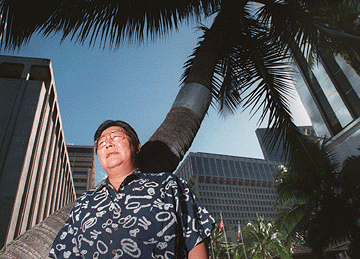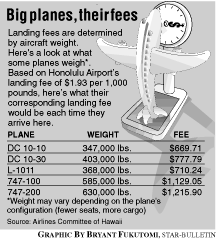



For a state whose economy relies on tourism, it's a welcome sight. But Circuit Judge Daniel Heely's ruling in the ceded-lands revenues case has led Watanabe to a different sort of vision, of landing fees possibly rising to such astronomical levels that they cut into the core of the visitor industry.
 "You know that you're going to get a reduction in flights and seats," he said, laying out a worst-case scenario. "You know you're going to get increased costs in transportation for cargo as well as passengers - interisland, international and overseas. You know that."
"You know that you're going to get a reduction in flights and seats," he said, laying out a worst-case scenario. "You know you're going to get increased costs in transportation for cargo as well as passengers - interisland, international and overseas. You know that."
Watanabe represents the Airlines Committee of Hawaii, a group of 22 major carriers that has estimated that the state's airport debt to the Office of Hawaiian Affairs could range from $594 million to $1.2 billion.
The numbers, larger than anyone thought before, heated a hot issue even further. Why so high? Because Heely's ruling implies a new way of calculating the debt, "the impacts of which went far beyond what I think he intended," Watanabe said.
OHA Chairman Clayton Hee calls the figures "propaganda," but Gov. Ben Cayetano is taking them "very seriously," his office said.
The dispute is over revenues derived from the airport's duty-free concession, now run by Duty Free Shoppers Ltd. The state is anxious because the concessions are the single largest source of operating funds for the airport system, which has been self-supporting since 1962. According to the state Transportation Department, total operating revenues in 1995 were $271.4 million, with $158.4 million coming from concession fees. The bulk was from the duty-free operation.
OHA has been getting a share because the airport is partly built on ceded lands. Up to now, though, the amount has been based only on sales made at the DFS store in the airport's international terminal.
 The agency sued, saying its share also should be based on sales made at DFS' lucrative Waikiki outlet, which accounts for about 80 percent of the company's business. It pointed out that DFS pays the state $100 million a year for rights to the concession, or 20 percent of gross revenues, whichever is greater. The state is trying to "double deal" itself, OHA argued, since it includes Waikiki sales when figuring the revenues, but not when paying OHA.
The agency sued, saying its share also should be based on sales made at DFS' lucrative Waikiki outlet, which accounts for about 80 percent of the company's business. It pointed out that DFS pays the state $100 million a year for rights to the concession, or 20 percent of gross revenues, whichever is greater. The state is trying to "double deal" itself, OHA argued, since it includes Waikiki sales when figuring the revenues, but not when paying OHA.
Heely agreed, and granted back payments to 1981 with interest.
The airlines committee says the debt to OHA works out to $594 million if revenues from off-airport outlets are included. But it thinks even more may be due because of the way Heely reached his decision.
Currently, the state calculates OHA's share using what Watanabe calls a "site-specific" method. Since only about 1 percent of DFS' airport retail space is on ceded land - 175 square feet out of 17,847 - the state takes 1 percent of the store's total gross revenues. OHA then gets 20 percent of that, the percentage it is entitled to under state law.
Heely, though, uses what Watanabe calls "but for" reasoning to reach his decision: But for the ceded land, there would be no airport; but for the airport, there would be no concession; but for the concession, there would be no Waikiki outlet. Under such logic, Watanabe maintains the current way of setting OHA's payment gets "thrown out the window" since the amount of floor space on ceded land is no longer a factor.
"It basically means it's 20 percent of all revenue generated on the airport, or off the airport, or wherever," he explained. "And that's where you get the billion two."
The committee's fear is that the debt might be shifted to the airlines through increased landing fees, now set at $1.93 per thousand pounds for overseas carriers. Even when the cost is spread over 30 years, fees would soar conservatively to $5.33 or $9.12, it says.
"There may come a time when the position of the state and the position of the airlines parts," Watanabe said. "That will probably be when the state decides they've lost the case and now they're going to charge the airlines for this."
But even if the state footed the bill, he sees ramifications.
"It doesn't make sense for us as airlines to preserve your right to land here with reasonable landing fees if what you've got when you get here is a state that's in financial shambles," he said. "It's a disaster either way."
OHA attorneys and the Hawaii Visitors Bureau executive committee have been briefed by Watanabe but declined comment. DFS Hawaii President John Reed said the issue has only indirect impact on his company.
One transportation expert, though, said a threefold to fivefold increase in landing fees could make marginal airlines think seriously about dropping their Hawaii service.
Fredrick Collison, a professor at the University of Hawaii School of Travel Industry Management, said U.S. airlines already have trimmed back costs and see Hawaii, a leisure market with low average fares, as a money loser. He said jacked-up fees also might accelerate a trend toward overflights, direct travel from the West Coast to Asia without stopovers in Hawaii.
But Collison felt a snowball effect on the visitor industry is not a given since airlines that continue flying here may just reduce off-season service to compensate for the added operating cost.
"Put it this way," he said. "It's certainly not going to be positive. I mean, the best we could hope for is no impact, and I really don't believe that would be the case."
Watanabe says he released his figures publicly after being urged to by Gov. Ben Cayetano. His intention is to add important information to the debate, and encourage the visitor industry, labor, government and other sectors of the community to address the "tremendous expectations" that were created for the native Hawaiian people and now are being questioned.
"It's not only the financial issues," he said. "It's how we deal with legitimate views and claims brought on by an indigenous community that has historically been screwed over."
